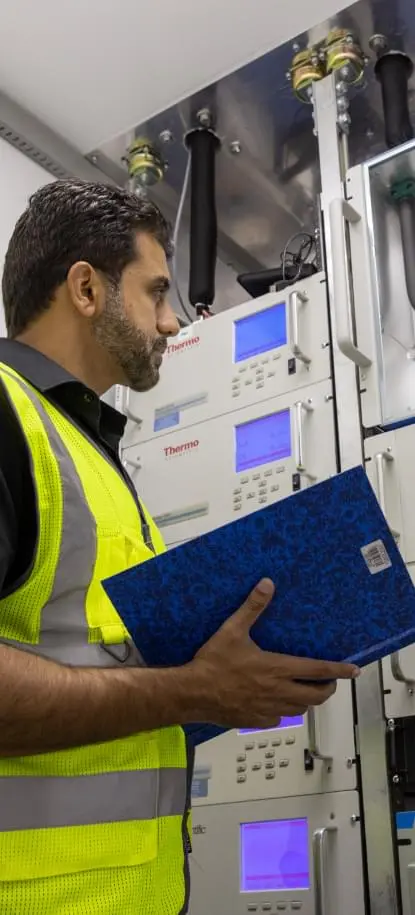




Quick Links:

KAUST operations and maintenance activities interacts with local environmental in various manner e.g. air emissions, marine discharges, waste generations, chemical or hydrocarbon use and storage. Environmental aspect and impact identification process of HSE is the method used to identify such interaction and identify control measures to mitigate and manage adverse environmental impacts.
The Operational Control Procedures sets out the guidelines for managing various environmental risks. It provides mandatory and clear instructions to the environmental risk owners with regard to process related controls that shall be put in place, monitoring and record keeping requirements.
These operational control procedures are aligned with local regulatory requirements and international best practiced standards. It communicates these requirements to the University stakeholders through various communication tools including intensive training program, and committee meetings.
Compliance with the requirements in operational control procedures are continuously monitored through a planned performance monitoring program consisting of inspection and series of internal and external audit program.
Waste management procedure provides necessary guidelines to all the contractor’s undertaking work within KAUST premises regarding how waste shall be managed onsite. The primary purpose of this procedure is to ensure waste generated from KAUST site is managed according to international best practices and in legally compliant manner. Waste management procedure covers both hazardous and non hazardous waste from non research activities.
Being situated at the shores of Red sea it is very important that KAUST operations activities interaction with the marine environment shall be minimized and managed in a way that it does not adversely impact the marine environment. Wastewater management procedure is a key operational control to ensure that discharges to marine environment is strictly regulated and control.
Wastewater management procedure set out the requirement for treatment, monitoring and discharge of wastewater produced from either construction or operation and maintenance activities. This procedure applies to all the activities within KAUST that require wastewater disposal to the environment.
The term “chemical” is a generic label for substances used across KAUST for activities including, but not limited to, operation and maintenance, fabrication and treatments. These chemicals may be in solid, liquid, or gaseous states and order to define the different types of chemicals a classification system is applied known as the Globally Harmonized System of Classification and Labeling of Chemicals.
The purpose of this Chemical Management Procedure (CMP) is to outline KAUST’s processes for managing the risks associated with the procurement, use, storage and disposal of chemicals, including generic spill response guidance for a variety of chemicals.
This CMP applies to all activities undertaken by all staff and contractors at KAUST operated and /or maintained sites with the exception of research laboratories and Chemical Warehouse.
The diverse nature of operations at KAUST has the potential to impact the local air quality in various ways ranging from stationary combustion sources, cooling towers, emergency generators and noise emissions. The purpose of this Air Quality Management Procedure (AQMP) is to develop a framework to protect local air quality from sources of pollution related to KAUST operations through design and operational guidelines along with administrative/recordkeeping requirements.
The AQMP applies to all activities undertaken by or on behalf of KAUST within KAUST site and covers sources of air emissions including, stationary combustion sources, mobile emission sources, fugitive dust, Nosie and odor emission sources.
This procedure outlines guidelines for procurement, storage, handling and emergency response in case of oil spills.The purpose of this Spill Prevention Control and Counter Measure (SPCC) Program is to set up a framework for the prevention of discharge of oil into KAUST properties including shorelines.
The SPCC Program applies oilcontaining equipment and devices that store 200 liters of oil or more: including aboveground oil storage tanks; undergroundstorage tanks, and; oilcontaining equipment or devices.
Construction Environmental Management Plan (CEMPs) are required to eliminate or minimize direct and indirect environmental impacts on air, land, surface water, groundwater, marine and terrestrial environments, cultural heritage, and community values during construction activities. CEMPs are integral to conforming to KAUST’s Environmental Stewardship Policy and the Kingdom of Saudi Arabia’s General Authority of Meteorology and Environmental Protection legal requirements.
KAUST CEMP procedure requires that construction projects must identify all the environmental impact and mitigation plan prior to mobilizing at the site. KAUST CEMP procedure provides a standard template for CEMP that shall be followed while developing a CEMP or as advised by KAUST HSE.